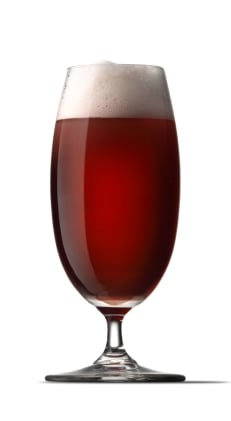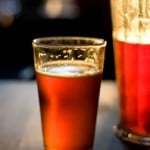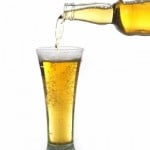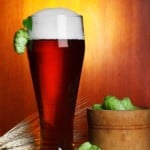 What’s in a glass? Hopefully a pint of your latest home brew! If we look beyond the obvious, your glassware choices for beer can heavily influence the presentation, character and finish of your beer. Glass choice impacts head retention, carbonation levels, aroma and perceived color of the beer. Some knowledge of glassware and its use is critical for the discerning home brewer or beer judge.
What’s in a glass? Hopefully a pint of your latest home brew! If we look beyond the obvious, your glassware choices for beer can heavily influence the presentation, character and finish of your beer. Glass choice impacts head retention, carbonation levels, aroma and perceived color of the beer. Some knowledge of glassware and its use is critical for the discerning home brewer or beer judge.
Some Beer Glass Basics
The diameter of the glass obviously will affect the perceived color of the beer. Pilsners are served in tall, thin tapered glass that highlights the light color of a the beer, as well as its clarity. The taper shows the clarity of the beer at varying diameter allowing you to perceive its full color spectrum. Darker beers are often served in pint glasses that emphasize their dark color or complete opacity.
The height of a glass highlights carbonation. Highly carbonated beers like Weizenbier or Pilsners are served in tall thin, narrow glasses that allow the carbonation from a significant volume of beer to form in a narrow surface area at the top. This showcases their high carbonation levels and enhances head retention.
Finally the shape of the glass can affect head retention, as well as aroma retention. Volatile gasses, lost over time after opening a beer, can be captured in certain glasses. For example the classic tulip glass (shown in the top right picture) has an inward taper at the top that tends to trap both carbonation and also aroma at the top of the glass. As a result, the tulip glass is great for highlighting both aroma and carbonation.
The Pint Glass
 The pint glass is the workhorse of English and many American pubs. It is cylindrical and comes in two variations, one straight walled and one with a slight rounded grip near the top. In the US the popular sizes are the pint (16 oz) and Imperial (Nonic) at 20 oz. They are inexpensive, easy to make and easy to store. The straight wall provides a straighforward presentation of the beer, and wide mouth provides ample room for a crowning head. Overall they provide a pretty neutral beer presentation, however.
The pint glass is the workhorse of English and many American pubs. It is cylindrical and comes in two variations, one straight walled and one with a slight rounded grip near the top. In the US the popular sizes are the pint (16 oz) and Imperial (Nonic) at 20 oz. They are inexpensive, easy to make and easy to store. The straight wall provides a straighforward presentation of the beer, and wide mouth provides ample room for a crowning head. Overall they provide a pretty neutral beer presentation, however.
These glasses are used with most American and English Ales including Amber, Pales, Porters, Stouts, Steam beer, Saison, Old Ales, IPAs, Browns, Barley wines and Scottish ales.
Pilsner Glass (Pokal)
 The pilsner glass is a tall, tapered, round, slender glass usually in a 12 oz size. The taper ends with a narrow rounded bottom and flat base, though some European pilsner glasses also have a stem (called a Pokal glass). The taper highlights the color and clarity of the beer, while the tall narrow glass showcases the beer’s high carbonation level and enhances head retention. The tall glass also helps to capture volatiles, and enhances the hop and malt aroma of the finished beer. Some highly carbonated beers are poured into the pilsen glass in stages, allowing them to settle a bit between pours to avoid excessive foaming.
The pilsner glass is a tall, tapered, round, slender glass usually in a 12 oz size. The taper ends with a narrow rounded bottom and flat base, though some European pilsner glasses also have a stem (called a Pokal glass). The taper highlights the color and clarity of the beer, while the tall narrow glass showcases the beer’s high carbonation level and enhances head retention. The tall glass also helps to capture volatiles, and enhances the hop and malt aroma of the finished beer. Some highly carbonated beers are poured into the pilsen glass in stages, allowing them to settle a bit between pours to avoid excessive foaming.
These glasses are most closely associated with European and American Pilsners, though many European lagers are served in them including Bocks, Viennas, Helles, Dunkel and even some Wheat beers such as highly carbonated Witbier.
Weizen Glass
 A thin walled, tall glass closely related to the pilsner glass, except they have a slightly curved shape at the top to capture the fuffy white head associated with Bavarian Weat beers. The tall glass and curved top helps trap the highly carbonated white head, and also locks in the banana-phenol aroma associated with the style.
A thin walled, tall glass closely related to the pilsner glass, except they have a slightly curved shape at the top to capture the fuffy white head associated with Bavarian Weat beers. The tall glass and curved top helps trap the highly carbonated white head, and also locks in the banana-phenol aroma associated with the style.
The weizen glass is most closely associated with Bavarian Weizen including Hefeweizen, Dunkelweisen, Kristal and Weizenbock. However many American wheat beers are served in them along with an occasional Pilsner.
The Tulip Glass
 Perhaps my personal all-around favorite glass for serving beer. The tulip is a stemmed glass with a tulip shaped head that retains the foamy head from its bulbous body. The tulip glass supports a large foamy head, provides a good view of the beer’s color and also captures volatile hop and malt aromas. I like it because it often brings out the best in a great beer, with a strong head and long lasting aroma.
Perhaps my personal all-around favorite glass for serving beer. The tulip is a stemmed glass with a tulip shaped head that retains the foamy head from its bulbous body. The tulip glass supports a large foamy head, provides a good view of the beer’s color and also captures volatile hop and malt aromas. I like it because it often brings out the best in a great beer, with a strong head and long lasting aroma.
The tulip shape is most closely associated with Belgian beers including Belgian strong, Darks, and IPAs, Flanders styles, Lambics, Gueuze, and Saison. Some Scottish ales and heavies are served in a “thistle glass” which is also tulip shaped.
And Many Others!
 I’ve only scratched the surface on this topic! Some other variations include German beer steins, the English yard glass, tankards, goblets, wine glasses, champagne flutes, snifters, tasters, growlers, conicals, bottles and the ever popular red Solo cup! You can enjoy beer from just about any container, but I tried above to cover some of the most popular styles used by home brewers above.
I’ve only scratched the surface on this topic! Some other variations include German beer steins, the English yard glass, tankards, goblets, wine glasses, champagne flutes, snifters, tasters, growlers, conicals, bottles and the ever popular red Solo cup! You can enjoy beer from just about any container, but I tried above to cover some of the most popular styles used by home brewers above.
What’s your favorite beer glass? Leave a comment below!
Thanks for joining me on the BeerSmith Home Brewing Blog. Be sure to sign up for my newsletter or my podcast (also on itunes…and radio station) for more great tips on homebrewing.
Hi there!
I prefer this glass as my all-round glass, and I have 20-30 pcs of this one from IKEA:
http://www.ikea.com/dk/da/catalog/products/30209338/
I costs DKK 9,00 and it’s about $1,60 🙂
-Peter
There are the ubiquitous pint pots with windows
There’s a glass blower in Louisville that is combining his love of beer and his love of glass. They aren’t cheap, but some of them look cool.
http://pretentiousglass.com/
My everyday glass is a promotional glass from Newcastle. I had several of these but am now down to one, the paint has long washed off and the family knows it as “Dad’s glass”.
http://www.thebeerspot.com/blogs/images/1391.jpg
Not sure of the type of glass but it has a good feel/balance to it. I drink mostly all kinds of beer from it.
There is nice collection of beer glasses but beer mug is one of my personal favorites, because it’s incredibly robust, easy to use and holds a lot of beer. Common in England, Germany and the United States, this type of beer glass comes in all sizes. you can add this one in your listing. Thanks BRAD SMITH.
I have a 1-pint cowhorn, with brass trimming – beer is traditional!?!